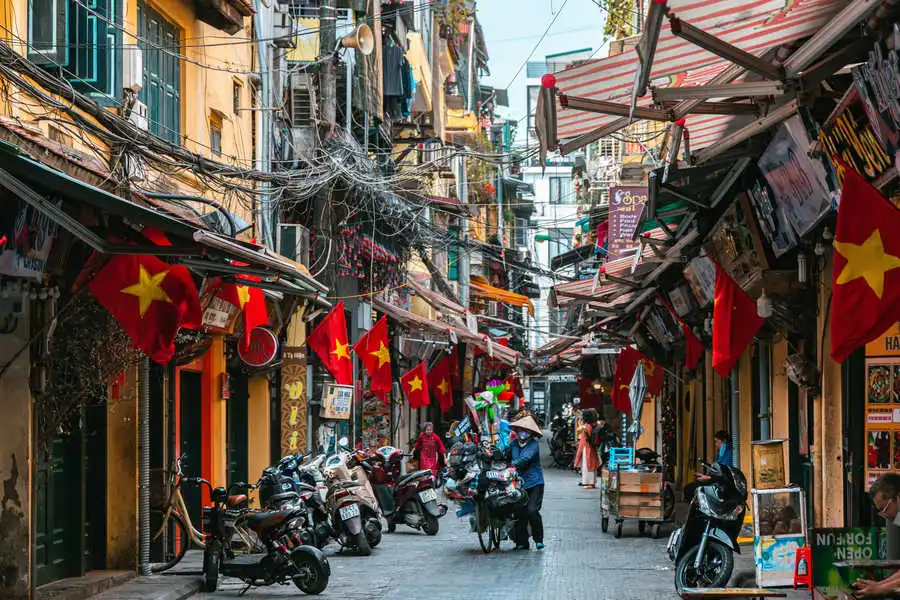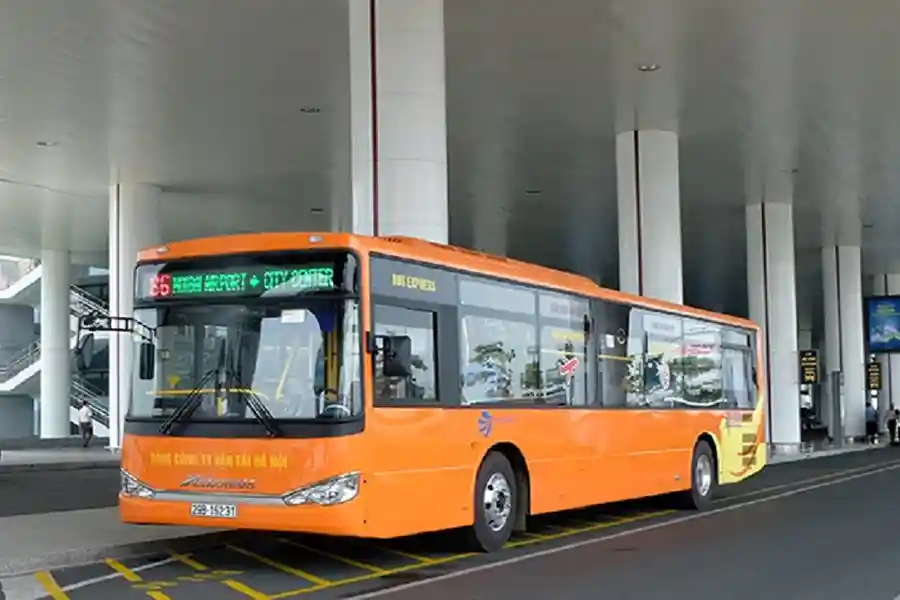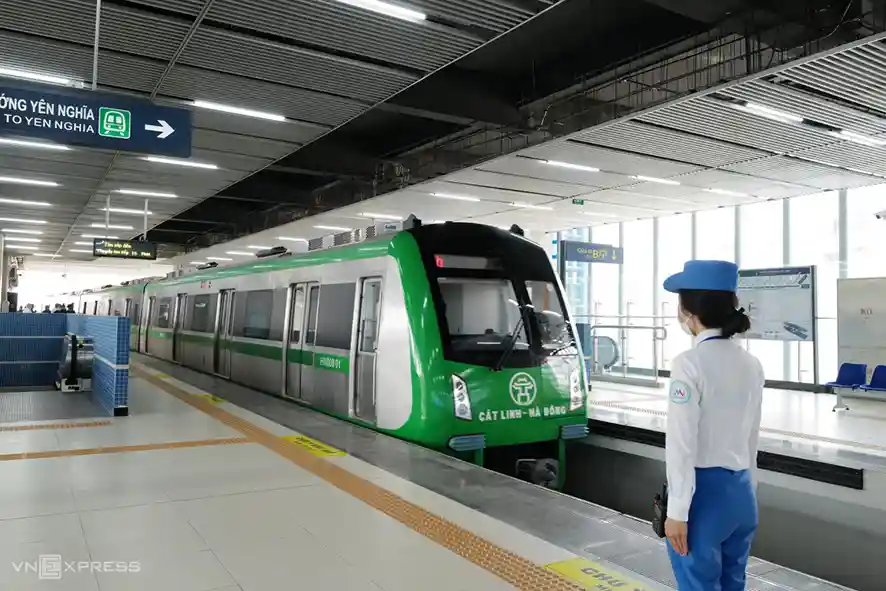Vietnam’s capital, Hanoi, is developing very rapidly. From a dense city with its typical narrow alleys, Hanoi is gradually expanding to become a true metropolis, requiring its means of transportation to modernize as well.
Upon arrival, you’ll likely be surprised by the wide variety of transportation options used: cars, motorbikes, bicycles, buses… and even cyclos and electric cars in some parts of the city!
To help you prepare for your visit to Hanoi, we’ve put together this small guide listing the different means of transportation available and how to use them.
If you’d like personalized advice for your trip, don’t hesitate to contact us.
Practical information about Hanoi
According to the latest 2019 census, the city of Hanoi (which is also a province of Vietnam) has a population of just over 8 million inhabitants. A millennia-old city, Hanoi boasts a wealth of well-preserved historical and cultural sites that reflect the country’s multicultural heritage.
The city developed in and around Hanoi’s Old Quarter, also known as the “36 Streets” or “36 Guilds”. Historically, this district was where artisans sold their crafts brought from the traditional villages scattered across the Red River Delta. Today, it remains the vibrant heart of tourism in Hanoi.
Most travelers visiting the city choose to stay in this district, located north of Hoan Kiem Lake. From there, it’s easy to explore the lively and typical streets of the capital on foot. Although much of the city can be explored by walking, if the traffic feels overwhelming, there are several other convenient means of transportation, which we’ll detail below.

Hoan Kiem Lake
How to visit downtown Hanoi?
Walking around the center of Hanoi
The center of Hanoi — meaning its Old Quarter and the area around Hoan Kiem Lake — is perfect for exploring on foot. This way, you can take your time discovering the small streets and stop to taste some typical dishes of the capital (street and home-style food being among the most famous in Vietnam).
It’s while strolling on foot that you’ll likely capture the best shots of the many street vendors.

Ta Hien Street in Hanoi
Little by little, the Hanoi authorities are implementing measures that favor pedestrians. Since 2017, the area around Hoan Kiem Lake has been closed to vehicles from Friday evening to Sunday evening. During these times, concerts and various activities are organized to entertain both young Hanoians and families.
If you’re traveling with children or visiting during the hot season (May – September), walking through the crowded alleys of central Hanoi can be quite exhausting. Fortunately, several alternatives allow you to explore the Old Quarter comfortably.
Exploring the Old Quarter by Cyclo
Did you know that the cyclo (pedicab) was invented by a Frenchman? Indeed, it was created by Pierre Maurice Coupeaud, a passionate cyclist and engineer from the École des Mines, while stationed in Phnom Penh in the late 1920s. His invention replaced the traditional rickshaw, which had fallen into disfavor due to its exploitative image.
The cyclo later became widely used by Vietnamese people during the wars of independence, serving many purposes — transporting goods, ammunition, and even wounded individuals to hospitals. Its image evolved over time: once a symbol of colonial-era luxury, it became a popular and practical means of transport.
So, don’t stop at the exotic and old-fashioned image of the cyclo… the drivers still exist, and it’s a gentle and peaceful way to explore the old town.
Many drivers will approach you in the Old Quarter to offer you a short ride. Expect to pay between 60,000 and 80,000 VND (about 2–3 euros) for a one-hour tour per person.
Exploring the Old Quarter by electric car
In recent years, it has become possible to visit Hanoi’s Old Quarter by electric car. Unlike a cyclo ride where you travel alone, an electric car allows you to chat easily with others — a great option if you’re in a large group and accompanied by a guide.
To book a tour, go to Dinh Tien Hoang Street, next to Dong Xuan Market. You can also find electric cars available for hire around the northern part of Hoan Kiem Lake. The vehicles have 8 seats and are equipped with a loudspeaker system providing commentary (if you’re visiting without a guide).
The price is per vehicle: 200,000 VND (about €8) for 35 minutes or 300,000 VND (about €12) for 60 minutes. You can divide the cost among your group, or even share the ride with other travelers on site.
It’s also possible to rent an electric car to explore the area around West Lake, located in the northwest of the city. The tour starts and ends near the entrance to Tran Quoc Pagoda, between Tay Ho (West Lake) and Truc Bach Lake. It’s a lovely excursion that will take you to several pagodas and temples off the beaten path.
These are our tips for visiting Hanoi’s city center. Not all tourist attractions are located in the Old Quarter, so you may need to travel further — here are the transport options available to help you do so.
How to visit Hanoi and its surroundings?
Rent a private car with driver
This is the most comfortable solution for visiting Hanoi and its surroundings. Tourists are not allowed to drive rental cars themselves, so you’ll need to book a driver from a company.
If you book a Hanoi discovery tour with Parfum d’Automne, you’ll be accompanied not only by a driver but also by a guide who will share interesting information about the places you visit.
You can also choose to hire only the driver’s services, but note this: in Vietnam, almost no driver (with very rare exceptions!) speaks English. He will do his job diligently and be very helpful, but you won’t be able to communicate easily. Depending on the distance traveled (whether you stay in Hanoi or explore nearby villages), the daily rental price may range from about 40 to 80 euros.
>> Check out our article on what to visit around Hanoi.
Renting Motorbikes / Scooters
If you’re a backpacker planning a motorbike trip through Northern Vietnam, you can start by exploring Hanoi on two wheels.
However, given the traffic conditions and the fact that road rules differ from those in many other countries, we generally do not recommend this mode of transport. If you are an experienced rider in your home country and aware of the risks (it’s always best to have travel insurance), then this option can still be considered.
Here are the approximate rental prices for a motorbike per day: 80,000 VND for an automatic scooter; 150,000 VND for a 150cc motorbike. For a week, prices range between 500,000 VND (around €20) and 1,500,000 VND (around €60), depending on the type of motorbike and your travel itinerary.
A good rental address is: Hanoi Motorbike, 37 Ngo (alley) Huyen, Hoan Kiem.
Other means of transport
Getting around by taxi
Among the most popular means of transport in Hanoi are taxis. You can cross the entire city for around €5 — so why not take advantage of it?
However, you should be careful and choose reliable taxi companies. Here are some trusted names: Ha Noi Taxi, Mai Linh Taxi, Thanh Nga Taxi, and Taxi Group. All these companies are now united under the G7 network, so you can safely hail a G7 taxi on the street. Here’s what these taxis look like:
For airport transfers, you can use Taxi Nội Bài: 024.38.86.8888.
As in many parts of the world, digital ride-hailing platforms have also made their appearance.
Opt for ride-hailing apps (Grab Taxi, Bee Bike, Go Viet)
Mobile applications offer several advantages: prices are fixed and non-negotiable (which helps avoid unpleasant surprises… like tampered meters!) and are very affordable. Moreover, these apps are constantly seeking new customers and frequently offer loyalty points or promotional codes
For both Vietnamese locals and tourists, booking online through these apps can be an excellent solution. Currently, the three main applications are Grab, Go Viet, and Bee Bike.
Through these platforms, you can book either motorbikes or cars. Motorcycle drivers are easy to recognize in the streets: Grab drivers wear green jackets, Go Viet drivers wear red, and Bee drivers wear yellow!

A Grab taxi driver in Hanoi
What are the steps to use these apps?
- Download the app on your phone
- Register your bank card number.
- Book the type of transport you want — you’ll see where the motorbike or car is located and how long it will take to reach you.
The main difficulty for tourists is that drivers, whether on motorbikes or in cars, often call customers to confirm their location, and most of them do not speak English.
Here are our tips: 1) Book when you are standing in front of a well-known landmark or a clearly identified address; 2)Pay close attention to the license plate — that’s how you’ll identify your motorbike or car.
Trying the bus?
Hanoi has not yet fully developed its bus network, and it does not particularly encourage tourists to use it. Nothing is written in English, and it can be quite difficult to find your way if you don’t understand Vietnamese. Moreover, as we’ve seen, there are so many other means of transportation available!
However, you might consider taking bus number 86 from Hanoi Airport (serving both the international and domestic terminals). As you exit the international terminal, bus 86 is clearly marked and easily recognizable thanks to its bright orange color. The ticket costs 30,000 VND (about €1.20), and it will take you all the way to Hanoi’s Old Quarter.
It’s a great option if you’re not carrying too much luggage or if you’d rather not pay around €15 for a taxi. The journey takes approximately 45 minutes from the international airport to downtown Hanoi.

Bus 86 to Hanoi Airport
And what about the metro?
This is Hanoi’s major infrastructure project, designed to reduce traffic congestion in the capital and to encourage new habits in public transportation.
The metro has been a long time coming. It’s a very complex project, as it involves a rapid urban transport system combining both elevated (skyline) and underground (subway) sections.
The first line of phase 1 has been operational since 2021. Thanks to it, Hanoians can now travel by metro from Cat Linh Street (near the Temple of Literature) to the Ha Dong district, located in the southern part of the city.
The final project will include 8 lines with a total length of 318 kilometers.

Hanoi Metro Line 1
You now know all the different ways to get around Hanoi!
All that’s left is to wish you a wonderful stay!




























